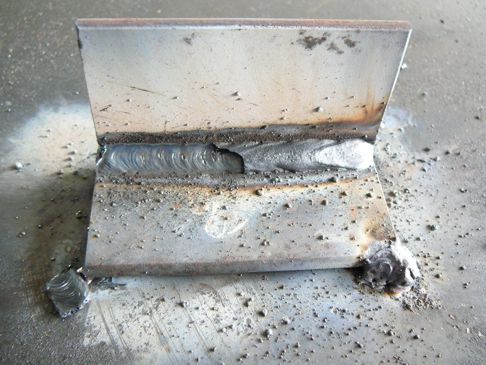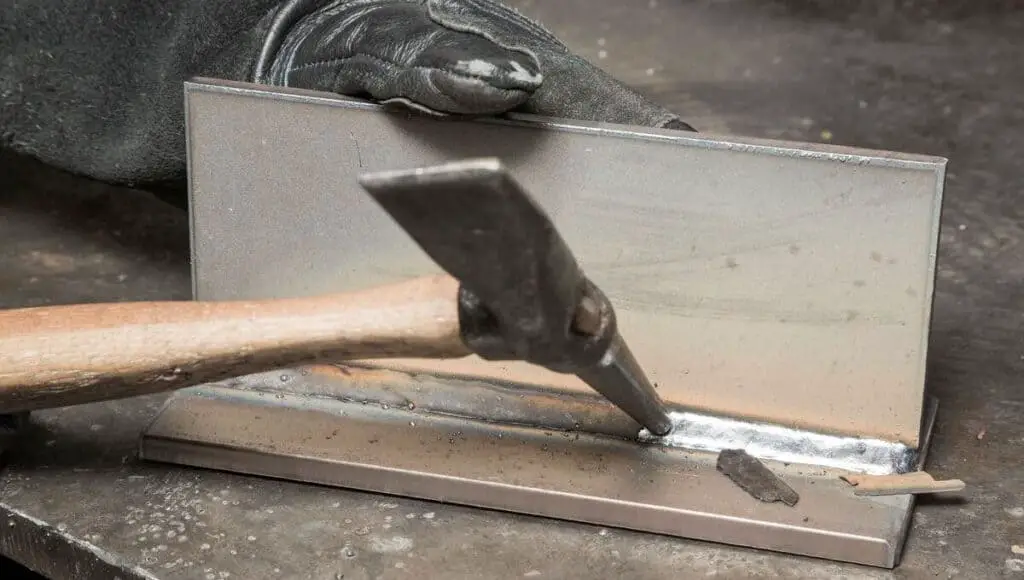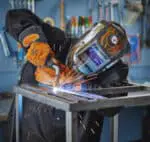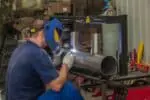Welding spatters might be caused from any problem with wire speed, shielding gas and the power settings. So, you need to be aware of the root cause of the spatters so that you can decrease their formation.
 Wondering how to detect them?
Wondering how to detect them?
Well this article will help you detect the ground problem of the cause of the spatters on your stainless steel from welding and will also provide solutions to eliminate them.
You can remove weld spatters from stainless steel using various techniques such as grinding, chipping, anti-spatter spray, sanding and the most used tools in all these processes are the hammer and the chisel.
Down the article, I will be explaining you all the techniques in details and some precautionary measures too that you need to take for your own safety while carrying out the weld spatter removal processes.
So, shall we get started?
What causes welding spatters and how to reduce weld spatters?
1. The wire feeding process has a major influence on the formation of spatters:
FCAW technique is the most common one used in welding. This technique calls for higher deposition rates and along with it comes a number of difficulties such as birdnesting and burnback.
Birdnesting tangles the wire and prevents it from being fed. In order to solve this problem you should use U-groove and the knurled V wire feeds.
Burnback melts the wire into a ball just at the contact tip end. This in turn causes slower wire feed.in order to solve this problem you should maintain contact tip distance of at least ¼”.
Few other preventive measures:
-
-
- Choose the right wire for the right metal
- The wire feed tension should not either be too loose or too tight
- There should not be any dust accumulation in the drive rollers. Dusty wire will lead to erratic feeding and hence more spatter
- In case of MIG welding, you should have enough shielding gas. The gas is paramount in stabilising the arc that will lead to less spatter
- Also, you need to choose the right shielding gas for the particular welding method you are applying
-
2. Poor connection in the working clamp can cause spatters:
If the connection in the working clamp is weak, it will lead to fluctuation of the welding arc, thus resulting in spatter.
How to prevent?
The clamp should perfectly fit into the working surface prior to the placement of the base metal. In other words, the clamp should be place as close as possible to the weld.
3. The presence of contaminants results into welding spatters:
When you are welding, there is always the presence of contaminants such as dust, paints, grease, rust and mill-scale. The contaminants act as a hindrance to smooth welding and thus produce spatters.
How to prevent?
-
-
- In case of rusty metals use the flux core electrode technique or the stick welding technique instead of MIG. This is because flux core electrode will provide deeper penetration that eliminates the rust.
- Always clean the welding surface and the tools you are going to use before beginning with the welding. You can use alkaline solution for the purpose.
- The wire spool also needs to be free of any contamination to reduce spatter.
- Stainless steel too catches rust easily. Therefore, it is essential to clean the metal itself before setting it for welding.
-
4. The wrong welding technique can also lead to spatters:
There are primarily two mistakes in the welding technique you are making and they are:
-
-
- If you position your gun at such an angle that pushes the gas to only one side, then it leaves the other side unprotected, which ultimately leads to spatters.
-
How to prevent?
In order to prevent this, position the weld at 5 to 15 degrees. This will allow the shielding gas to spread evenly on the entire surface of the weld area, thus preventing spatters.
-
-
- In case your electrode is too long and is sticking out, it might cause jabs to the welding pool, thus increasing the chances of spatters.
-
How to prevent?
Try having shorter electrodes, but not too short though. The recommended length is a stick out of ½” for flux core and 3/8” in case of MIG.
5. Incorrect wire speed settings or welding settings can also influence spatters:
Polarities will vary for a solid wire to flux cored. In case the welder forgets to change the setting, it can lead to spatter. Another reason is the too much speed of the wire speed setting.
Therefore, it is advisable to follow the welding chart for every process and every metal to be used.
How to remove weld spatter from stainless steel?
1. Remove weld spatter using hammer and chisel:
This process is known as chipping. Just position the chisel at 35 degrees on the spattered area and then beat with the hammer with the intensity not to damage the base metal but just to clean off the spatter.

Do not forget to wear your safety glasses while the chipping process as spatter particles might get scattered here and there and might enter your eyes and injure them.
2. Remove weld spatter using anti-spatter spray:
A number of anti-spatter sprays are available in the market or you can get one from amazon.com. What you need to do is just spray the product on the spattered areas and wait for 10 to 15 minutes and then brush off using a metal brush or sandpaper. Do not forget to wipe clean using a cloth.
3. Remove weld spatter using grinding and flap disc techniques:
You will need two equipment for this purpose: a flap disc and an angle grinder. All you need to do is just connect the flap disc to the angle grinder and then turn on the flap disc and begin removing the spatters.
4. Remove weld spatter using slide hammer chisel:
Slide hammer chisel is just your regular slide hammer with a chisel at its end. If you can’t find this in the market, you can easily make it at home just by welding a nut at the end of a chisel and then screw it onto the slide hammer.
It will help you to reach the next to impossible spots while cleaning the spatter from the stainless steel.
See also: How to weld stainless steel without wraping
Before winding up:
At the first place try to avoid the formation of weld spatters using the preventing measures stated above and still if you notice the spatters, you can use any of the suitable techniques mentioned in the article to eliminate the weld spatters!
But above all, do not forget to take precautionary measures for yourself like wearing safety glasses and safety gloves so that you do not get injured!
And with that it’s time to take your leave till we meet again in our next article!
Stay tuned to our website and do not miss on any expert tips for all your welding problems!
Have a great day ahead!






